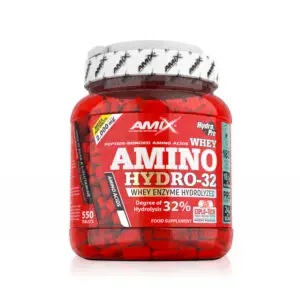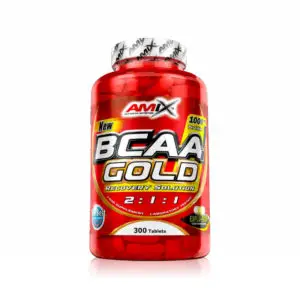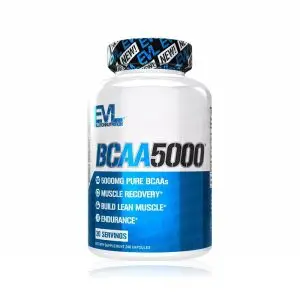
Strengthening the immune system: The role of vitamins and minerals
In a world full of pathogens and stress factors, a strong immune system is our most important line of defense. The immune system consists of a complex

Share with:

Essential amino acids (EAAs), as opposed to the more familiar branched-chain amino acids (BCAAs), offer a more complete profile of required nutrients, which is actually the better option. Their impact on muscle building and training performance can be significant, but to take full advantage of the effects, the right timing is crucial.
Here we will give you a close look at the function and importance of EAAs, their differences to BCAAs and examine the benefits of EAA supplementation. We will analyze when during training EAAs are most effective, highlight dosage recommendations and discuss specific considerations for optimal use of these supplements.
Essential amino acids (EAAs) are indispensable building blocks of proteins that the human body cannot produce itself. They must therefore be ingested in sufficient quantities through food. There are a total of nine of these essential amino acids, which play a central role in protein synthesis and in all bodily functions.
Essential amino acids (EAAs) play a central role in the human body and are essential for building muscle tissue and protein biosynthesis, especially for athletes and bodybuilders. As the body cannot produce EAAs itself, they must be obtained from food or supplements.
Essential amino acids (EAAs) and branched-chain amino acids (BCAAs) are both popular dietary supplements among athletes and fitness enthusiasts. The main difference lies in their amino acid profile. While BCAAs consist of the three branched-chain amino acids leucine, isoleucine and valine, EAAs include all nine essential amino acids, including the aforementioned BCAAs. This means that EAAs provide a broader spectrum of nutrients that are essential for various bodily functions. They have the advantage of being calorie and sugar free, which is why they are particularly popular in calorie restricted diets. While EAAs can have a complete effect in lower daily doses, they are particularly beneficial for women, as they not only promote muscle building, but also positively influence bone health and hormonal balance.
Essential Amino Acids (EAAs) are important building blocks of proteins and play a crucial role in muscle building and regeneration. Many fitness enthusiasts are concerned with the question of when it is best to take them.
Before training: Consuming EAAs can improve muscle performance and increase protein synthesis. This optimally prepares the body for upcoming training sessions and maximizes performance.
During training: A continuous supply of EAAs is particularly beneficial during intensive and long training sessions. They help to prevent muscle breakdown and ensure a constant supply of amino acids.
After training: EAAs taken immediately afterwards promote muscle protein synthesis and effectively support muscle building. They make a valuable contribution to rapid regeneration.
| Time | Advantage |
| Before training | Increased performance |
| During training | Constant supply of amino acids |
| After training | Regeneration and muscle building |
A comprehensive supply before, during and after training ensures that the muscles and body are adequately supplied with valuable proteins. Such an intake strategy could provide your new favourite product to maximize your training success.
They play a central role in the diet of active athletes in particular, as they prevent muscle breakdown and promote muscle regeneration. The timing of the intake of EAAs is crucial in order to take full advantage of their benefits. It is often recommended to take a dose of around 10 grams of EAAs around training. This can be done before, during or after the training session in order to optimally support muscle protein synthesis and ensure a continuous supply during intensive training sessions. EAAs can thus serve both as a source of energy and improve endurance during longer training sessions.
The benefits of EAA supplements are manifold and play an important role in muscle building. By supporting muscle protein synthesis, EAAs make a significant contribution to building muscle mass. They also counteract catabolic processes that could otherwise promote muscle breakdown. Another decisive advantage of EAAs is that they not only accelerate muscle regeneration, but also improve the supply of oxygen to the muscles. This leads to increased performance and is particularly beneficial during intensive training sessions. If EAAs are taken directly after training, muscle regeneration can be significantly improved, as the muscles are particularly receptive to nutrients during this phase.
The intake of essential amino acids (EAAs) plays a central role in the daily training routine of many athletes. The timing of intake can significantly influence how effectively EAAs fulfill their crucial role in muscle building and regeneration. Taken before training, EAAs can help to reduce muscle breakdown and increase endurance. After training, on the other hand, they promote protein synthesis and support muscle regeneration. For those on fasting periods or restrictive diets, EAAs offer the benefit of maintaining muscle mass and boosting metabolism. Experts recommend a daily intake of 10 to 20 grams of EAAs before or after training to reap these benefits.
Taking EAAs during training is the best alternative. During intense or long training sessions, the constant supply of essential amino acids can prevent muscle breakdown by continuously supplying the body with the required building blocks of protein. This continuous supply is particularly valuable as it helps to optimize energy supply and delay fatigue.
Another key benefit of taking EAAs during training is that they support muscle protein synthesis, which promotes muscle growth. By improving physical performance and reducing fatigue, they contribute to effective muscle utilization.
The intake of EAAs during training optimizes muscle recovery in particular. This makes EAAs an important part of the diet for athletes who want to increase their physical performance while maintaining their muscle mass. Ultimately, EAAs consumed during training can bring about significant increases in performance.
The correct dosage of EAA supplements is crucial to efficiently support muscle protein synthesis and improve muscle recovery. Essential amino acids (EAAs) play a central role in building muscle mass as they are the building blocks of proteins that are essential for various bodily functions. Well-designed EAA supplementation can ensure the supply of these vital nutrients during intensive training sessions and thus provide optimal support for muscle building.
To stimulate muscle protein synthesis and achieve a positive nitrogen balance, a dosage of 10 to 12 grams of EAAs is recommended. Of this amount, 1 to 3 grams should consist of L-leucine, as this plays a particularly important role in the metabolism. During intensive training or increased stress, the need for these essential amino acids can increase. An increased dosage makes sense in such cases in order to avoid deficits. The next exciting intake option can act as a new favorite product with the further benefit of a balanced, protein-rich diet, as EAAs are seen as an important part of this form of nutrition.
Essential amino acids are central to protein biosynthesis, tissue repair, energy production and hormone regulation. As the body cannot produce these important protein components itself, a sufficient and continuous supply throughout the day is crucial. A customized intake is important and depends on personal goals and health status to achieve the optimal benefits.
Essential amino acids (EAAs) play a central role in building muscle mass and supporting protein biosynthesis, as the body cannot produce them itself and they usually have to be taken in via proteins. For an optimal supply, EAAs should be taken before or after training. This promotes muscle regeneration and supports muscle building.
Compared to complete proteins, free EAAs offer decisive advantages: they do not need to be broken down, which ensures faster availability and better tolerability. This makes them an ideal companion during intensive and long training sessions.
EAAs also help to provide energy and delay muscle fatigue, so taking them before training can be particularly beneficial. Thanks to their low-calorie properties, they are also an attractive option for athletes and the diet-conscious, as they promote muscle building without unnecessarily increasing calorie intake.























EAA supplements are extremely relevant for fitness and strength athletes as they support muscle building and recovery after training. Essential amino acids (EAAs) are indispensable as the body cannot synthesize them itself. A sufficient supply through diet or supplementation is therefore essential.
EAA supplements are particularly important for vegetarian and vegan athletes to ensure they have all the amino acids they need to build muscle. In addition to promoting muscle cell regeneration, EAAs can also have a positive effect on bone health and hormonal balance, especially in women.
Overall, EAA supplements are an important component for an optimal supply during intensive training sessions and should be considered an integral part of any training plan.
Share with:
Related articles

In a world full of pathogens and stress factors, a strong immune system is our most important line of defense. The immune system consists of a complex

Creatine occupies a special place in the world of dietary supplements, known for its ability to boost athletic performance. While
About
FATBURNERKING


© copyright 2018-2025 Fatburnerking.at
| Cookie | Duration | Description |
|---|---|---|
| cookielawinfo-checkbox-advertisement | 1 year | This cookie is set by the GDPR Cookie Consent Plugin and is used to record the user's consent for the cookies in the "Advertising" category. |
| cookielawinfo-checkbox-analytics | 11 months | This cookie is set by GDPR Cookie. The cookie is used to store user consent for cookies in the "Analytics" category. |
| cookielawinfo-checkbox-functional | 11 months | The cookie is set based on the consent of the GDPR cookies to record the user's consent for cookies in the "Functional" category. |
| cookielawinfo-checkbox-necessary | 11 months | This cookie is set by GDPR Cookie. Cookies are used to store the user's consent to the storage of cookies in the "Necessary" category. |
| cookielawinfo-checkbox-others | 11 months | This cookie is set by GDPR Cookie. The cookie is used to store the user's consent for cookies in the "Other" category. |
| cookielawinfo-checkbox-performance | 11 months | This cookie is set by GDPR Cookie. The cookie is used to store user consent for cookies in the "Performance" category. |
| CookieLawInfoConsent | 1 year | Records the default button status of the corresponding category and the status of CCPA. It only works in coordination with the primary cookie. |
| elementor | never | This cookie is used by the website's WordPress theme. It allows the website owner to implement or change the content of the website in real time. |
| viewed_cookie_policy | 11 months | The cookie is set by the GDPR cookie and is used to store whether the user has consented to the use of cookies or not. It does not store any personal data. |
| Cookie | Duration | Description |
|---|---|---|
| ssupp.vid | 6 months | Cookie set by Smartsupp to record the visitor ID. |
| ssupp.visits | 6 months | Cookie set by Smartsupp to record the number of previous visits, necessary to track automatic messages. |
| Cookie | Duration | Description |
|---|---|---|
| _ga | 2 years | The _ga cookie installed by Google Analytics calculates visitor, session and campaign data and also tracks website usage for the website analytics report. The cookie stores information anonymously and assigns a randomly generated number to identify unique visitors. |
| _gat_gtag_UA_179465762_1 | 1 minute | Set by Google to distinguish users. |
| _gid | 1 day | The _gid cookie installed by Google Analytics stores information about how visitors use a website and at the same time creates an analytics report about the website's performance. Some of the data collected includes the number of visitors, their source and the pages they visit anonymously. |
| tk_ai | 5 years | JetPack sets this cookie to store a randomly generated anonymous ID that is only used in the administration area and for general analytics tracking. |
| tk_lr | 1 year | The tk_lr is a referral cookie set by the JetPack plug-in on websites using WooCommerce that analyses referral behaviour for Jetpack. |
| tk_or | 5 years | The tk_or is a referral cookie set by the JetPack plug-in on websites using WooCommerce that analyses referral behaviour for Jetpack. |
| tk_qs | 30 minutes | JetPack sets this cookie to store a randomly generated anonymous ID that is only used in the administration area and for general analytics tracking. |
| tk_r3d | 3 days | JetPack installs this cookie to collect internal metrics for user activity to improve the user experience. |
| tk_tc | Session | JetPack sets this cookie to record details of how users use the website. |
| Cookie | Duration | Description |
|---|---|---|
| _fbp | 3 months | This cookie is set by Facebook to display ads after visiting the website, either on Facebook or on a digital platform powered by Facebook Ads. |
| fr | 3 months | Facebook sets this cookie to display relevant ads to users by tracking user behaviour on the web, on websites with Facebook Pixel or Facebook Social Plug-in. |
| Cookie | Duration | Description |
|---|---|---|
| cookies.js | Session | No description available. |
| weglot_wp_rocket_cache | Session | No description |